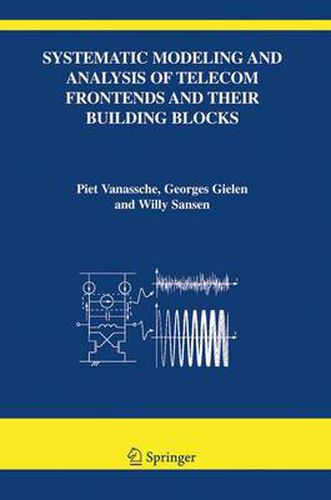Readings Newsletter
Become a Readings Member to make your shopping experience even easier.
Sign in or sign up for free!
You’re not far away from qualifying for FREE standard shipping within Australia
You’ve qualified for FREE standard shipping within Australia
The cart is loading…






This title is printed to order. This book may have been self-published. If so, we cannot guarantee the quality of the content. In the main most books will have gone through the editing process however some may not. We therefore suggest that you be aware of this before ordering this book. If in doubt check either the author or publisher’s details as we are unable to accept any returns unless they are faulty. Please contact us if you have any questions.
nalog circuits are fascinating artifacts. They manipulate signals whose informa- Ationcontentisrichcomparedtodigitalsignalsthatcarryminimalamountofinf- mation;theyaredelicateinthatanyperturbationduetoparasiticelements,todelays,to interactionswithotherelementsandwiththeenvironmentmaycauseasigni?cantloss ofinformation. Thedif?cultyindealingwiththeseartifactsistoprotectthemfromall possibleattacks, evenminorones, fromthephysicalworld. Theironyisthattheyare oftenusedtofunnelinformationfromandtothephysicalworldtoandfromtheabstr- tionofthedigitalworldandforthisfunction, theyareirreplaceable. Nowonderthen that analog designers form a club of extraordinary gentlemen where art (or magic?) ratherthanscienceisthesharedtrade. Theyaredif?culttotrainsinceexperienceand intuitionarethetraitsthat characterize them. Andthey have dif?cultiesinexplaining what is the process they use to reach satisfactory results. Tools used for design (s- ulation) are mainly replacing the test benches of an experimental lab. However, the growing complexity of the integrated systems being designed today together with the increasing fragility of analog components brought about by shrinking geometries and reducedpowerconsumptionisposingseverechallengestotraditionalanalogdesigners to produce satisfactory results in a short time. At the same time, the need for expe- enced analog designers has increased constantly since almost all designs, because of integration,docontainanalogcomponents. Thissituationhascreatedastronginterest in developing design methodologies and supporting tools that are based on rigorous, mathematically literate, approaches. Doing so will make it possible to leverage the expertiseofseasonedanalogdesignersandtotrainnewgenerationsfasterandbetter. Inthepast, severalattemptshavebeenmadeinacademia andindustrytocreatethese methodologies and to extend the set of tools available. They have had questionable acceptance in the analog design community. However, recently, a ?urry of start-ups andincreasedinvestmentbyEDAcompaniesinnoveltoolssignalasigni?cantchange inmarketattentiontotheanalogdomain. Ipersonallybelievethattosubstantially- prove quality and design time, tools are simply insuf?cient. A design methodology based on a hierarchy of abstraction layers, successive re?nement between two ad- cent layers, and extensive veri?cation at every layer is necessary. To do so, we need to build theories and models that have strong mathematical foundations. The analog design technology community is as strong as it has ever been.
$9.00 standard shipping within Australia
FREE standard shipping within Australia for orders over $100.00
Express & International shipping calculated at checkout
This title is printed to order. This book may have been self-published. If so, we cannot guarantee the quality of the content. In the main most books will have gone through the editing process however some may not. We therefore suggest that you be aware of this before ordering this book. If in doubt check either the author or publisher’s details as we are unable to accept any returns unless they are faulty. Please contact us if you have any questions.
nalog circuits are fascinating artifacts. They manipulate signals whose informa- Ationcontentisrichcomparedtodigitalsignalsthatcarryminimalamountofinf- mation;theyaredelicateinthatanyperturbationduetoparasiticelements,todelays,to interactionswithotherelementsandwiththeenvironmentmaycauseasigni?cantloss ofinformation. Thedif?cultyindealingwiththeseartifactsistoprotectthemfromall possibleattacks, evenminorones, fromthephysicalworld. Theironyisthattheyare oftenusedtofunnelinformationfromandtothephysicalworldtoandfromtheabstr- tionofthedigitalworldandforthisfunction, theyareirreplaceable. Nowonderthen that analog designers form a club of extraordinary gentlemen where art (or magic?) ratherthanscienceisthesharedtrade. Theyaredif?culttotrainsinceexperienceand intuitionarethetraitsthat characterize them. Andthey have dif?cultiesinexplaining what is the process they use to reach satisfactory results. Tools used for design (s- ulation) are mainly replacing the test benches of an experimental lab. However, the growing complexity of the integrated systems being designed today together with the increasing fragility of analog components brought about by shrinking geometries and reducedpowerconsumptionisposingseverechallengestotraditionalanalogdesigners to produce satisfactory results in a short time. At the same time, the need for expe- enced analog designers has increased constantly since almost all designs, because of integration,docontainanalogcomponents. Thissituationhascreatedastronginterest in developing design methodologies and supporting tools that are based on rigorous, mathematically literate, approaches. Doing so will make it possible to leverage the expertiseofseasonedanalogdesignersandtotrainnewgenerationsfasterandbetter. Inthepast, severalattemptshavebeenmadeinacademia andindustrytocreatethese methodologies and to extend the set of tools available. They have had questionable acceptance in the analog design community. However, recently, a ?urry of start-ups andincreasedinvestmentbyEDAcompaniesinnoveltoolssignalasigni?cantchange inmarketattentiontotheanalogdomain. Ipersonallybelievethattosubstantially- prove quality and design time, tools are simply insuf?cient. A design methodology based on a hierarchy of abstraction layers, successive re?nement between two ad- cent layers, and extensive veri?cation at every layer is necessary. To do so, we need to build theories and models that have strong mathematical foundations. The analog design technology community is as strong as it has ever been.